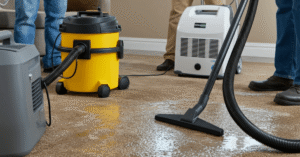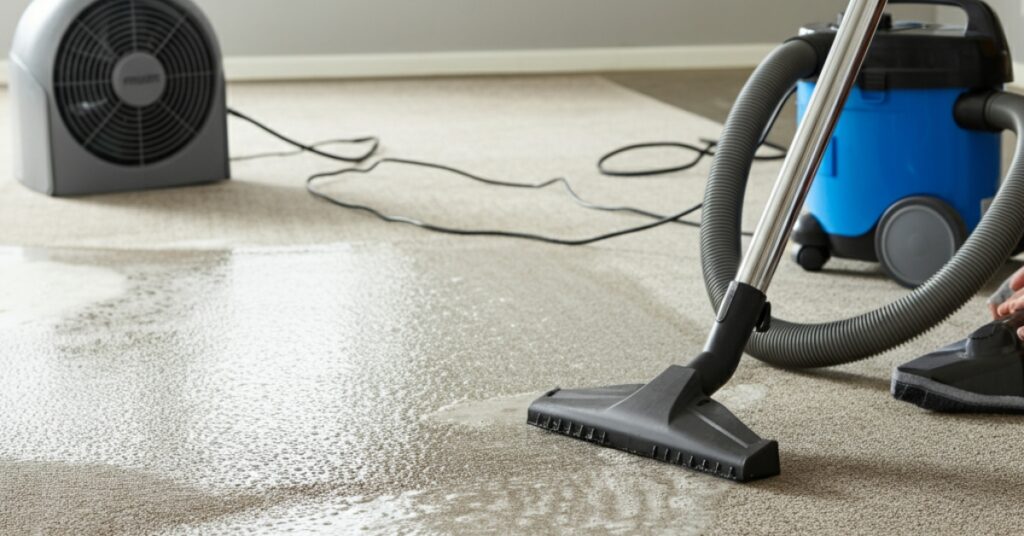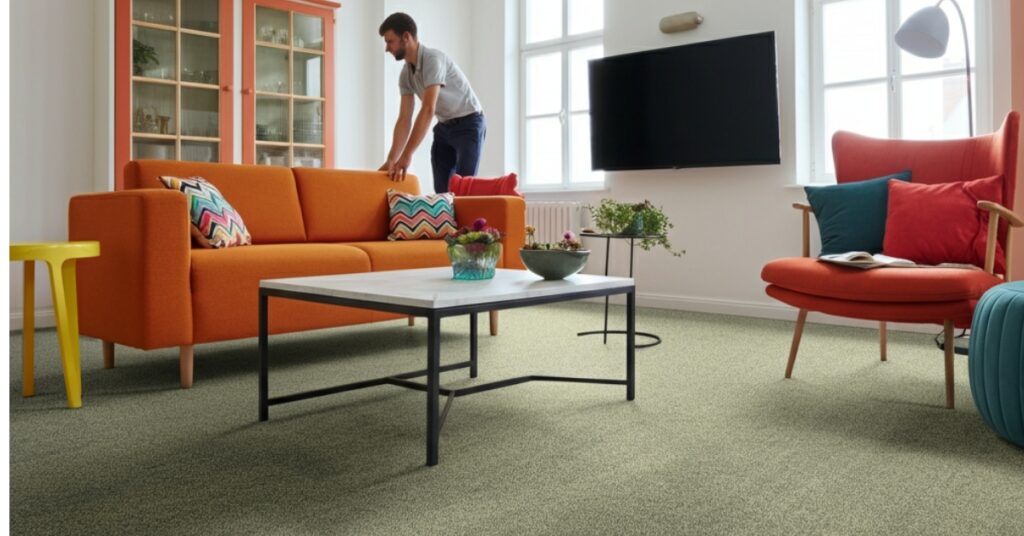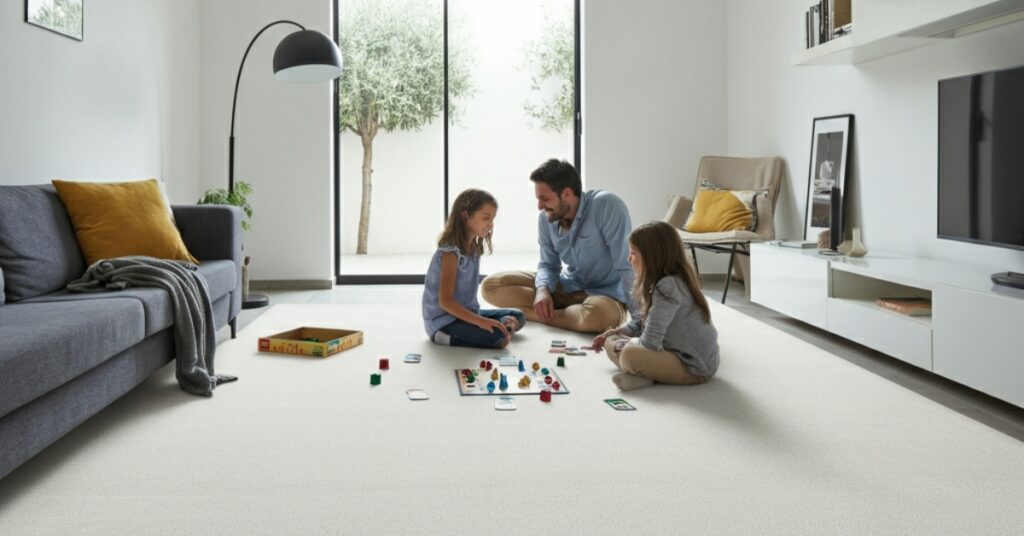As an Amazon Associate, I earn from qualifying purchases.
After a professional carpet cleaning, your home feels refreshed and looks much cleaner. However, you’re left with damp floors and a common question: how long does carpet take to dry? The answer isn’t always simple. Drying times can range from just a few hours to over a day, depending on several factors.
Knowing the typical drying time helps you plan accordingly, ensuring you can get back to your normal routine without damaging your freshly cleaned carpets. This detailed guide covers everything you need to know about carpet drying times, the factors that influence them, and what you can do to speed up the process safely. We’ll explore different cleaning methods, the role of humidity and airflow, and tips to ensure your carpet dries correctly and stays in great condition.
Factors That Affect How Long Carpet Takes to Dry
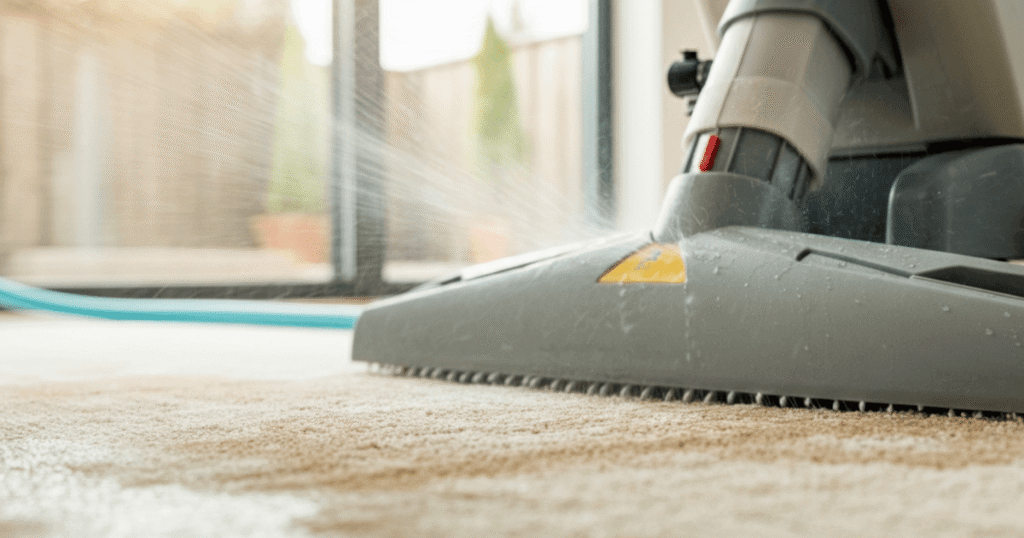
Several key elements determine how quickly your carpet will dry. Understanding these factors will help you set realistic expectations and take steps to shorten the waiting period. A professional cleaner can give you a more precise estimate, but these are the universal variables that impact the drying process for any carpet.
Type of Carpet Fiber
The material your carpet is made from plays a significant role in its drying time. Natural fibers, like wool, are highly absorbent and tend to hold onto moisture longer than synthetic materials. Because wool can absorb up to 30% of its weight in water, it often requires a longer drying period, sometimes extending beyond 24 hours if the environment is humid.
On the other hand, synthetic fibers such as nylon and polyester are less absorbent. These materials are designed to repel water, which allows them to dry much more quickly. Carpets made from these fibers can often be dry to the touch within 6 to 10 hours under ideal conditions. Olefin is another synthetic fiber that is particularly water-resistant, making it one of the fastest-drying options available.
Cleaning Method Used
The method used to clean your carpet has the most direct impact on how long it takes to dry. Some cleaning techniques use significantly more water than others, which naturally leads to longer drying times.
Hot Water Extraction (Steam Cleaning)
Hot water extraction, often called steam cleaning, is a deep-cleaning method that injects a mixture of hot water and cleaning solution deep into the carpet fibers. A powerful vacuum then extracts the dirty water. Although this method provides a thorough clean, it can leave the carpet quite damp. The drying time for steam-cleaned carpets is typically between 6 and 12 hours, but it can take up to 24 hours if ventilation is poor. The efficiency of the vacuum used during extraction is crucial; a more powerful machine will remove more water and reduce drying time.
Dry Carpet Cleaning
Dry cleaning methods use very little to no water, making them an excellent option if you need a fast drying time. One popular technique involves a special powder or compound that is sprinkled onto the carpet and worked into the fibers with a machine. This compound absorbs dirt, and after a short period, it is vacuumed up. Since minimal moisture is used, carpets cleaned this way are often ready to be walked on almost immediately or within an hour. This method is ideal for high-traffic commercial areas or homes where long downtimes are not practical.
Amount of Airflow in the Room
Proper airflow is essential for accelerating the drying process. Air movement helps to carry away the moisture evaporating from the carpet fibers. A stuffy, closed-off room will trap humidity, slowing down evaporation and extending how long it takes for the carpet to dry. This can also increase the risk of mold and mildew growth.
To improve airflow, you can open windows and doors to create a cross-breeze. Using fans is also highly effective. Ceiling fans can circulate air throughout the room, while portable box or oscillating fans can be directed at the carpet surface. The more air you can get moving across the carpet, the faster it will dry.
Humidity and Temperature Levels
The ambient climate inside your home significantly influences evaporation rates. High humidity means there is already a lot of moisture in the air, which slows down the rate at which water can evaporate from your carpet. In humid climates or on a rainy day, drying times will naturally be longer.
Temperature also plays a role. Warmer air can hold more moisture than cooler air, which aids in the evaporation process. Turning up the heat slightly can help your carpet dry faster. Using a dehumidifier is one of the most effective ways to combat high humidity, as it actively removes moisture from the air, creating a drier environment that encourages faster evaporation from the carpet. Conversely, an air conditioner can also help by lowering indoor humidity levels.
How to Speed Up Carpet Drying Time
While you might have to wait for your carpet to dry, there are several effective steps you can take to make the process quicker. Applying these tips will not only shorten the waiting period but also help prevent issues like mold, mildew, or musty odors from developing.
Use Fans for Air Circulation
One of the simplest and most effective ways to reduce drying time is to increase air circulation. Position several fans around the room to blow air directly across the surface of the carpet. Ceiling fans are also great for this, as they help move air throughout the entire space.
If you have portable fans, place them at different angles to ensure all areas of the carpet receive adequate airflow. This continuous movement of air helps whisk away moisture as it evaporates from the carpet fibers, significantly speeding up the process. Even a small amount of airflow can make a big difference.
Open Windows for Ventilation
If the weather outside is not too humid, opening windows and doors can create a natural cross-breeze. This fresh air helps to carry moist air out of the room while bringing drier air in. This method is most effective on dry, breezy days.
However, be cautious about opening windows if it is raining or the humidity outside is high, as this could introduce more moisture into the room and slow down the drying process. In such cases, it’s better to keep the windows closed and rely on fans and your home’s HVAC system instead.
Use a Dehumidifier
A dehumidifier is an excellent tool for speeding up carpet drying time, especially in humid environments. This appliance works by pulling moisture out of the air, which in turn encourages faster evaporation from the carpet.
For best results, place the dehumidifier in the center of the room with the damp carpet. Close the windows and doors to allow the machine to work efficiently within a contained space. You might be surprised at how much water it collects, all of which would have otherwise remained in the air and your carpet.
Turn on the Air Conditioning or Heat
Your home’s HVAC system can be a powerful ally in drying your carpet. If it’s a warm, humid day, running the air conditioner will help lower the indoor humidity, much like a dehumidifier. The AC system is designed to remove moisture from the air as part of its cooling process.
Conversely, if it’s a cool day, turning on the heat can also help. Warmer air can hold more moisture, which promotes faster evaporation. Setting your thermostat to a comfortable, slightly warm temperature (around 70-75°F or 21-24°C) can create an ideal environment for drying. The fan from your HVAC system will also help circulate the air.
Avoid Walking on the Carpet
It is crucial to stay off the damp carpet as much as possible. Walking on a wet carpet can compress the fibers, making it harder for air to circulate through them. This can create flattened spots that take much longer to dry.
Furthermore, wet carpet fibers are more susceptible to attracting dirt. Your shoes can transfer soil onto the clean, damp fibers, leading to immediate resoiling. If you absolutely must walk on the carpet, wear clean socks or shoe covers to minimize the transfer of dirt.
Why You Shouldn’t Let Your Carpet Stay Wet for Too Long
Letting your carpet remain wet for an extended period is not just inconvenient; it can lead to serious problems that can affect your health and your home’s integrity. Quick drying is essential to prevent these issues.
Risk of Mold and Mildew
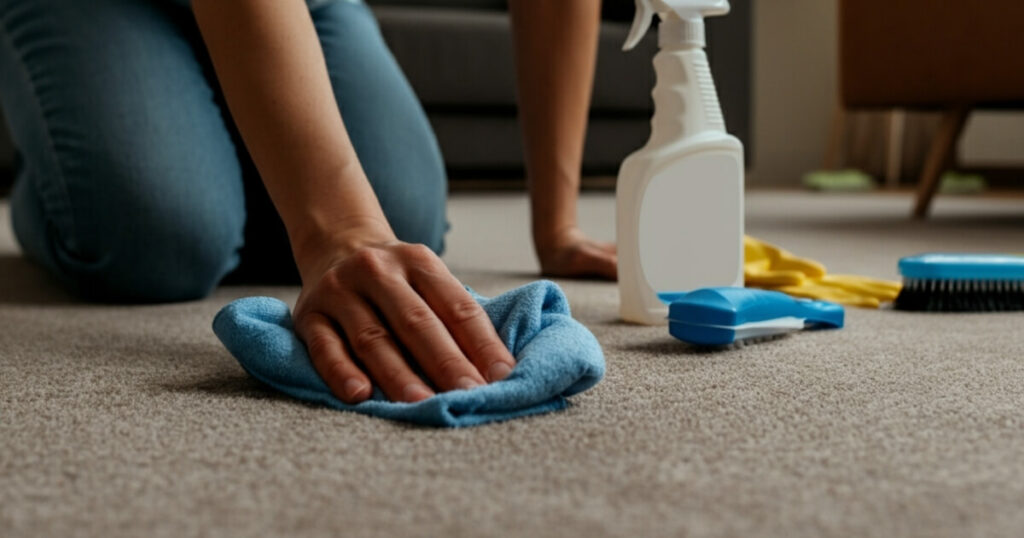
Mold and mildew thrive in damp, dark environments. A wet carpet provides the perfect breeding ground for these fungi. Mold spores are always present in the air, and when they land on a moist surface, they can begin to grow within 24 to 48 hours.
Once mold takes hold in your carpet and padding, it can be very difficult and expensive to remove. It can cause musty odors that permeate your home and can also lead to health problems, especially for individuals with allergies, asthma, or other respiratory conditions.
Damage to Carpet Backing and Subfloor
Prolonged moisture can cause significant damage to the structural components of your flooring. The carpet backing, which holds the fibers together, can weaken, stretch, or separate when it stays wet for too long. This is known as delamination and can ruin your carpet.
Even more concerning is the potential damage to the subfloor beneath the carpet. Wood subfloors can absorb moisture, leading them to swell, warp, or even rot over time. This can compromise the structural integrity of your floor and lead to costly repairs.

Frequently Asked Questions
1. How long does carpet take to dry to the touch?
A carpet may feel dry to the touch within 3 to 6 hours, but this doesn’t mean it’s completely dry. Moisture can still be trapped deep within the fibers and the padding underneath. It’s best to wait for the professionally recommended time, usually 6 to 12 hours, before resuming heavy foot traffic.
2. Can I put furniture back on a damp carpet?
No, you should avoid placing furniture back on a damp carpet. The weight of the furniture can crush the wet fibers, and moisture trapped underneath can damage both the carpet and the furniture itself. Wood stains can transfer onto the carpet, and metal legs can leave rust marks that are very difficult to remove. Wait until the carpet is completely dry.
3. What happens if my carpet takes more than 24 hours to dry?
If your carpet is still damp after 24 hours, the risk of mold and mildew growth increases significantly. At this point, you should take immediate action to accelerate the drying process. Increase airflow with more fans, use a dehumidifier, and contact your cleaning professional if you are concerned. They may be able to return with specialized equipment to help extract more moisture.
4. Is it normal for my carpet to smell after cleaning?
A slight odor after carpet cleaning can be normal and is often due to the cleaning solutions used or the release of trapped odors from the carpet fibers. This smell should dissipate as the carpet dries. However, if a persistent musty or sour smell develops, it could be a sign of mildew growth, and you should address the moisture issue immediately.
Final Verdict
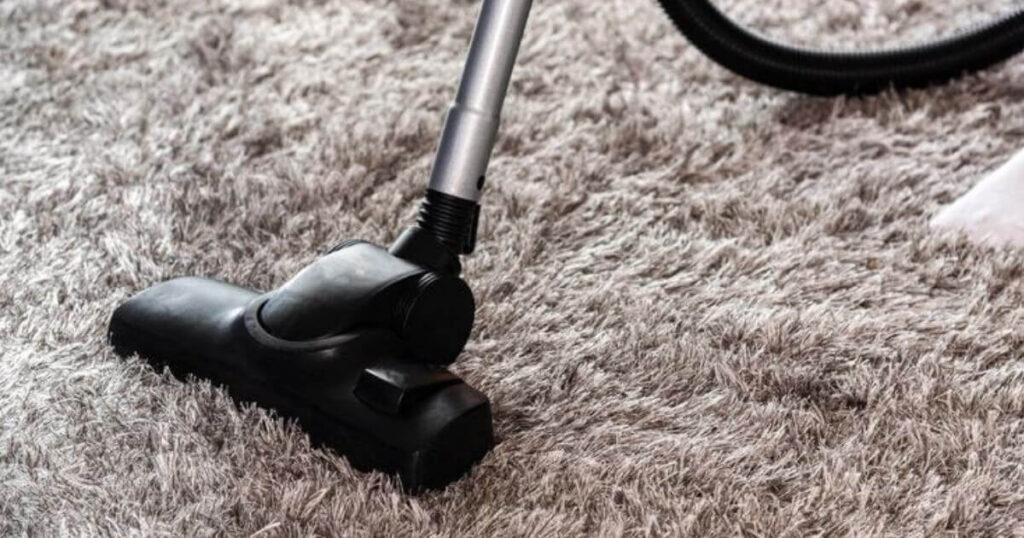
Knowing how long carpet takes to dry is the first step, but ensuring it dries correctly is just as important. By understanding the factors at play and taking proactive steps to speed up the process, you can enjoy your clean, fresh carpets sooner and protect your investment.
Remember to promote good airflow, manage humidity levels, and keep foot traffic to a minimum. These simple actions will help prevent problems like mold, mildew, and damage to your flooring. If you have any concerns about the drying process, don’t hesitate to reach out to your carpet cleaning professional for advice and assistance.
As an Amazon Associate, I earn from qualifying purchases.

